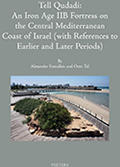Citation:

Abstract:
Final Report on the Hebrew University of Jerusalem Excavations Directed by E.L. Sukenik and S. Yeivin, with the Participation of N. Avigad
This monograph presents the final excavation report of the Iron Age fortress at Tell Qudadi (Tell esh-Shuna) situated on the northern bank of the Yarkon river estuary in the central coast of Israel. The main excavations were conducted in 1937-38 and were published in a very preliminary form, dating the first phase of the fortress to the 10th or 9th century BC, whereas the second phase, attributed by the excavators to the northern Israelite kingdom, was ascribed to the latter part of the 9th century BC until 732 BC, when it was destroyed during the military campaign led by Tiglath-pileser III. Such a reconstruction of events was unreservedly accepted by other scholars. The present authors offer a new chronological scheme for two architectural phases of this impressive Iron Age fortress, suggesting a new chronological affiliation of the fortress to the period between the second half of the 8th and the first half of the 7th centuries BC. Accordingly, the site formed an integral part of the sophisticated logistical network that was created on behalf of the Neo-Assyrian rule. The study of the site's Iron Age IIB pottery assemblages enables a reassessment of a number of contested chronological issues in a wider Mediterranean setting.
